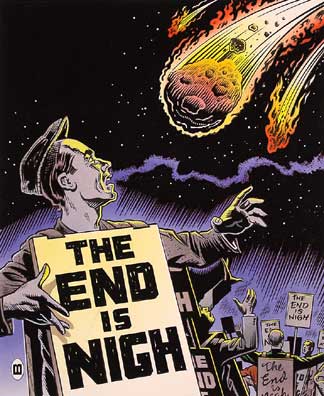Asteroid 2012 DA14: footage of a meteor smacking into Earth
 LOOK out! This is a video of a meteor smacking into the Urals. The impact injured 200 people. The meteor could be linked to asteroid 2012 DA14. That’s just passing by us. Phil Plait notes:
LOOK out! This is a video of a meteor smacking into the Urals. The impact injured 200 people. The meteor could be linked to asteroid 2012 DA14. That’s just passing by us. Phil Plait notes:
[E]xcluding actual impacts, 2012 DA14 will be still only be the eighth-closest approach by a known asteroid on record. The closest on record without actually hitting us was 2011 CQ1, which, in 2011, passed us by about 5500 km (3300 miles)—less than Earth’s radius! It was only about a meter across, so even if it had hit us we would’ve gotten a spectacular fireball, but probably no actual damage.
However, this is the largest asteroid we’ve seen come this close. Even then, it’s only 50 meters across, which is small as asteroids go.
In the game of cosmic roulette that is our solar system, we just got lucky. Earth will get a very close shave on Friday, Feb. 15, when Asteroid 2012 DA14 passes just 17,000 miles from our planet. That is less than the distance from New York to Sydney and back, or the distance the Earth travels around the sun in 14 minutes. We are dodging a very large bullet.
The people of Earth also are getting a reminder that even in our modern society, our future is affected by the motion of astronomical bodies. The ancients were correct in their belief that the heavens affect life on Earth—just not in the way they imagined. Sometimes those heavenly bodies actually run into Earth. That is why we must make it our mission to find asteroids before they find us.
The last major asteroid impact on Earth was on June 30, 1908, when one about the size of an office building (140 feet across) slammed into Siberia with a destructive energy 700 times that of the atomic bomb dropped on Hiroshima. That asteroid devastated a region roughly the size of the San Francisco Bay area. Asteroid 2012 DA14, which will be passing over our heads on Friday, is about the same size as the asteroid that devastated Siberia’s Tunguska region. . . .
The chance of another Tunguska-size impact somewhere on Earth this century is about 30%. That isn’t the likelihood that you will be killed by an asteroid, but rather the odds that you will read a news headline about an asteroid impact of this size somewhere on Earth. Unfortunately, that headline could be about the destruction of a city, as opposed to an unpopulated region of Siberia. . . .
The chance in your lifetime of an even bigger asteroid impact on Earth—with explosive energy of 100 megatons of TNT—is about 1%. Such an impact would deliver many times the explosive energy of all the munitions used in World War II, including the atomic bombs.
What if an asteroid hit the Earth?
In this case, let’s imagine that the conclusion is a truly bad one—that our football-field sized rock would be targeting a populated area. And for the sake of doomsday pizzaz, let’s make that populated area New York City.
An 830 sq. mi blast ring has a radius of 14.4 mi. (23.2 km). Position that over New York City and you’d have destruction reaching deep into Queens in the east and Staten Island in the South; west to Paterson and Montclair, NJ; and north to Yonkers and New Rochelle, NY. Manhattan, the Bronx and Brooklyn would be swallowed whole. Evacuation in advance of the blast would be a massive challenge, since the array of bridges and tunnels that connect the boroughs are natural choke points. The many months of notice the residents would have before the big day arrived would make things a bit easier, but fleeing from an asteroid is very different from fleeing from other kinds of disasters. People evacuating in advance of, say, a hurricane can usually just load up their cars and go, since even after a superstorm like Katrina, most of them will simply be turning around and coming home. After a Tunguska-like blast, most people would not have any home left at all.
Time for space guns…
Posted: 15th, February 2013 | In: Reviews Comment (1) | TrackBack | Permalink


